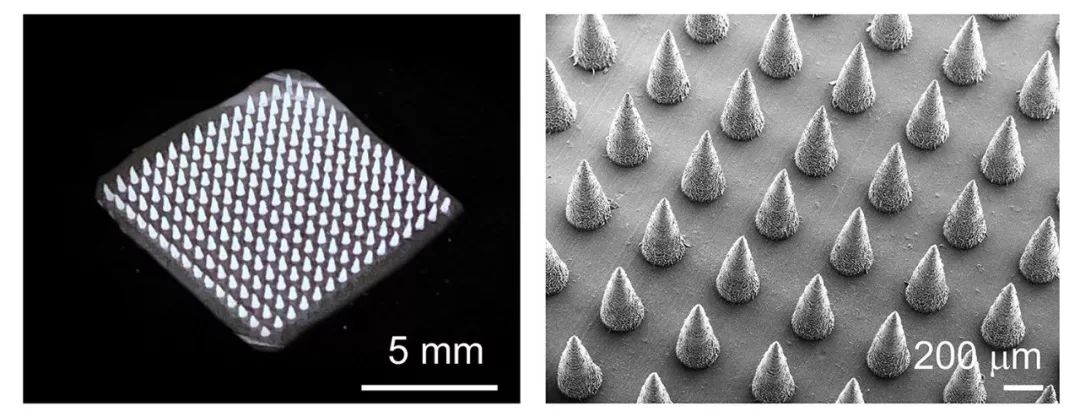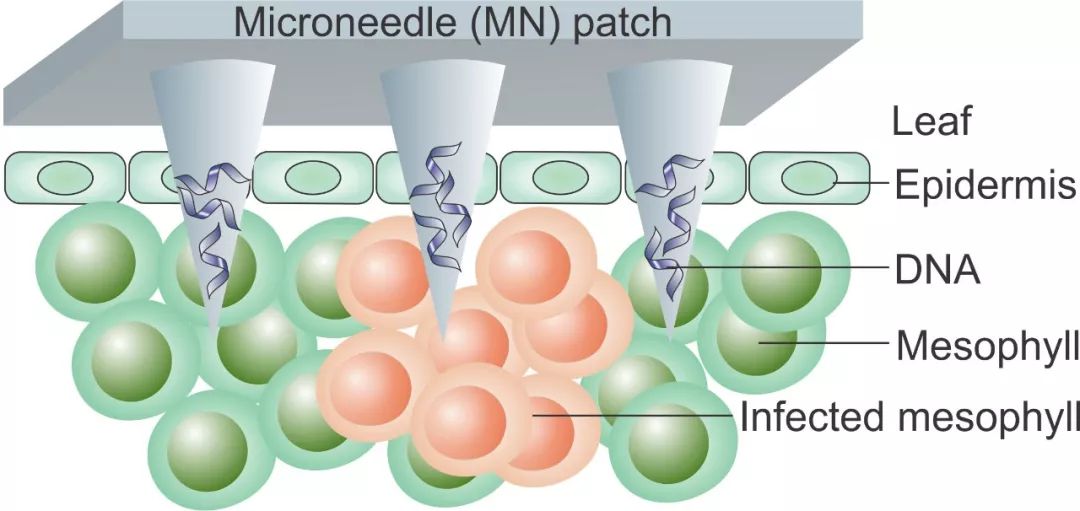科技工作者之家
科技工作者之家APP是专注科技人才,知识分享与人才交流的服务平台。
科技工作者之家 2019-06-23
来源:科研圈
传统 DNA 提取技术需要好几个小时,最近,北卡罗莱纳州立大学(North Carolina State University)的研究人员开发了一种新技术,能在一分钟内从植物组织中提取收集 DNA,相关论文于 6 月 9 日发表在《美国化学会·纳米》(ACS Nano)上。DNA 提取是鉴定植物病害的第一步,新方法使用了微针贴片(microneedle patch),有助于开发小型化、可以用于现场即时检测的植物病害诊断工具。

来源 北卡罗莱纳州立大学
编辑 徐文慧
北卡罗莱纳州立大学化学和生物分子工程系助理教授魏青山说:“当农民发现田间可能出现的植物病害,如马铃薯晚疫病(由马铃薯晚疫病菌 Phytophthora infestans 引起)时,他们希望能立刻知道该疾病是什么。快速检测对于控制植物病害的迅速传播非常重要。”魏青山同时也是文章的通讯作者。
"快速检测的障碍之一是从植物样品中提取高质量的 DNA 需要耗费较长时间,我们的技术则为这一问题提供了一个快速、简单的解决方案。"魏青山说。
"一些植物病害有类似的症状。如导致历史上著名的爱尔兰饥荒的马铃薯晚疫病,和其姊妹物种烟草疫霉(Phytophthora nicotianae)引起的疫病症状就非常相似,"北卡罗莱纳州立大学植物病理学系教授、论文的共同通讯作者琼·里斯塔伊诺(Jean Ristaino)说,"DNA 分子检测是目前鉴定植物疾病的标准方法。我们的新技术非常重要,因为在从样品中提取 DNA 之前,你无法对马铃薯晚疫病或任何其他植物病害菌株进行扩增或基因测定。”
实验室通常使用十六烷基三甲基溴化铵(cetyltrimethylammonium Ammonium Bromide, CTAB)法从植物样品中提取 DNA,该方法必须在实验室中完成,需要大量设备,并且至少要耗费 3~4 小时。CTAB 提取是一个多步骤过程,包括从植物组织研磨到有机溶剂萃取和离心机纯化的整个流程。

图片来源 | DOI: 10.1021/acsnano.9b00193
相比之下,新的 DNA 提取技术只涉及微针贴片和水性缓冲溶液。微针贴片仅邮票大小,由一种低廉的聚合物制成,贴片一侧的表面由数百个 0.8 毫米长的微针组成。
农民或研究人员可以将微针贴片应用于他们怀疑产生病害的植物。应用时,只要将贴片按压到植物叶面可疑区域几秒钟,然后将其剥离;接下来用缓冲溶液冲洗贴片,将微针头上吸附的 DNA 遗传物质收集入无菌容器中。整个过程大约只需要一分钟。

图片来源 | DOI: 10.1021/acsnano.9b00193
加州大学洛杉矶分校(University of California, Los Angeles)生物工程学教授、该论文的共同通讯作者顾臻说:"很高兴看到微针贴片技术在农业和植物科学领域的新应用。”
"在实验测试中,我们发现与传统的 CTAB 提取相比,微针技术提取的样品杂质含量略高,"魏青山说,"然而,微针技术的纯度水平与实验室其他常用的 DNA 提取方法相当。最重要的是,我们发现微针技术和 CTAB 提取之间的轻微纯度差异并没有干扰后续 DNA 放大检测的准确度。”
"事实上,微针提取的采样体积偏小似乎不是问题,"北卡罗莱纳州立大学化学和生物分子工程系的博士生拉杰什·保罗(Rajesh Paul)说,"在最近的一项盲测中,微针技术成功地从所有野外采集的受感染番茄叶片中提取了病原体 DNA。”保罗是也是该论文的第一作者。
"DNA 提取一直是现场即时检测工具开发的一个重大障碍,"魏青山说,"我们现在的目标是创建一个集成的、低成本的现场便携式设备,该设备可以执行从采集样本到识别病原体和报告化验结果过程的每一步。”
New Microneedle Technique Speeds Plant Disease Detection
Matt Shipman
Researchers have developed a new technique that uses microneedle patches to collect DNA from plant tissues in one minute, rather than the hours needed for conventional techniques. DNA extraction is the first step in identifying plant diseases, and the new method holds promise for the development of on-site plant disease detection tools.
“When farmers detect a possible plant disease in the field, such as potato late blight, they want to know what it is right away; rapid detection can be important for addressing plant diseases that spread quickly,” says Qingshan Wei, an assistant professor of chemical and biomolecular engineering at North Carolina State University and co-corresponding author of a paper on the work.
“One of the obstacles to rapid detection is the amount of time it takes to extract DNA from a plant sample, and our technique provides a fast, simple solution to that problem,” Wei says.
“Some plant diseases have similar leaf symptoms, such as late blight caused by the famed Irish famine pathogen Phytophthora infestans, and Phytophthora blight caused by a sister species P. nicotianae,” says Jean Ristaino, William Neal Reynolds Distinguished Professor of Plant Pathology at NC State and co-corresponding author of the paper. “The gold standard for disease identification is a molecular assay. Our new technique is important because you can’t run an amplification or genotyping assay on strains of P. infestans, or any other plant disease, until you’ve extracted DNA from the sample.”
Typically, DNA is extracted from a plant sample using a method called CTAB extraction, which has to be done in a lab, requires a lot of equipment, and takes at least 3 to 4 hours. CTAB extraction is a multi-step process involving everything from tissue grinding to organic solvents and centrifuges.
By contrast, the new DNA extraction technique involves only a microneedle patch and an aqueous buffer solution. The patch is about the size of a postage stamp and is made of an inexpensive polymer. The surface on one side of the patch is made up of hundreds of needles that are only 0.8 millimeters long.
A farmer or researcher can apply the microneedle patch to a plant they suspect is diseased, hold the patch in place for a few seconds, then peel it off. The patch is then rinsed with the buffer solution, washing genetic material off of the microneedles and into a sterile container. The entire process takes about a minute.
“It is exciting to see the new application of microneedle patch technology in agriculture and plant science,” says Zhen Gu, a professor of bioengineering at the University of California, Los Angeles and co-corresponding author of the paper, who developed several microneedle-based drug delivery systems for human health.
“In experimental testing, we found that the microneedle technique does result in slightly higher levels of impurities in the sample, as compared to CTAB,” Wei says. “However, the microneedle technique’s purity levels were comparable to other, validated laboratory methods of DNA extraction. Most importantly, we found that the slight difference in purity levels between the microneedle and CTAB samples did not interfere with the ability to accurately test the samples by a PCR or LAMP assay.”
“The fact that microneedles extract a smaller sampling volume seems not to be an issue,” says Rajesh Paul, a Ph.D. student at NC State and first author of the paper. “The microneedle technique successfully extracted pathogen DNA from all field-collected infected tomato leaves in a recent blind test.”
“DNA extraction has been a significant hurdle to the development of on-site testing tools,” Wei says. “We are now moving forward with the goal of creating an integrated, low-cost, field-portable device that can perform every step of the process from taking the sample to identifying the pathogen and reporting the results of an assay.”
The paper, “Extraction of Plant DNA by Microneedle Patch for Rapid Detection of Plant Diseases,” is published in the journal ACS Nano. The paper was co-authored by Amanda Saville, lab manager in Ristaino’s lab; Jeana Hansel, a graduate student at NC State; Carmin Ball and Alyssa Williams, undergraduates at NC State; Yanqi Ye, a former graduate student in the Joint Biomedical Engineering Department at NC State and the University of North Carolina, Chapel Hill; Xinyuan Chang, an undergraduate at Tianjin University who worked as a visiting researcher at NC State; and Guojun Chen, postdoctoral researcher at UCLA.
The work was done with support from the NC State Chancellor’s Faculty Excellence Program on Emerging Plant Disease and Global Food Security, the Kenan Institute for Engineering, Technology & Science at NC State, and the USDA Integrated Pest Information Platform for Extension and Education, under grant number 2015-0097.
论文信息
【标题】Extraction of Plant DNA by Microneedle Patch for Rapid Detection of Plant Diseases
【作者】Rajesh Paul, Amanda C. Saville, Jeana C. Hansel, Carmin Ball, Alyssa Williams, Jean B. Ristaino and Qingshan Wei, North Carolina State University; Yanqi Ye, Joint Biomedical Engineering Department at North Carolina State University and the University of North Carolina, Chapel Hill; Xinyuan Chang, Tianjin University; Guojun Chen and Zhen Gu, University of California, Los Angeles
【期刊】ACS Nano
【DOI】10.1021/acsnano.9b00193
【摘要】In-field molecular diagnosis of plant diseases via nucleic acid amplification (NAA) is currently limited by cumbersome protocols for extracting and isolating pathogenic DNA from plant tissues. To address this challenge, a rapid plant DNA extraction method has been developed using a disposable polymeric microneedle (MN) patch. By applying MN patches on plant leaves, amplification-assay-ready DNA can be extracted within a minute from different plant species. MN-extracted DNA has been used for direct polymerase chain reaction (PCR) amplification of plant plastid DNA without purification. Furthermore, using this patch device, extraction of plant pathogen DNA (Phytophthora infestans) from both laboratory-inoculated and field-infected leaf samples was performed for detection of late blight disease in tomato. MN extraction achieved 100% detection rate of late blight infections for samples after 3 days of inoculation when compared to the conventional cetyltrimethylammonium bromide (CTAB)-based DNA extraction method as a gold standard, and 100% detection rate for all blind field samples tested. This simple, cell lysis-free, and purification-free DNA extraction method could be a transformative approach to facilitate rapid sample preparation for molecular diagnosis of various plant diseases directly in the field.
【链接】https://pubs.acs.org/doi/10.1021/acsnano.9b00193
来源:keyanquan 科研圈
原文链接:http://mp.weixin.qq.com/s?__biz=MzA5NDkzNjIwMg==&mid=2651681820&idx=2&sn=22872485e30376b2b85f93f0cdb37323&chksm=8bbed9f9bcc950ef11db1120d7b286f7ecbf091481485f40846bf5aabeee4b5009ac5543d837&scene=27#wechat_redirect
版权声明:除非特别注明,本站所载内容来源于互联网、微信公众号等公开渠道,不代表本站观点,仅供参考、交流、公益传播之目的。转载的稿件版权归原作者或机构所有,如有侵权,请联系删除。
电话:(010)86409582
邮箱:kejie@scimall.org.cn

科学家探索物种间DNA组成多样性背后的奥秘

双语科普┋口罩可以阻挡多少霾?

夫妻相真的存在,研究发现夫妻DNA相似度高过陌生人
演化:“最奇怪动物”身份揭秘

双语科普┋切辣椒防辣手
线粒体DNA
DNA重组

非对称聚合物材料可制造灵活多变的软机器人

自然中不存在的蛋白质也能人造了!撼动材料医药界
合成生物学: 一个用来控制转基因生物的内置毁灭开关